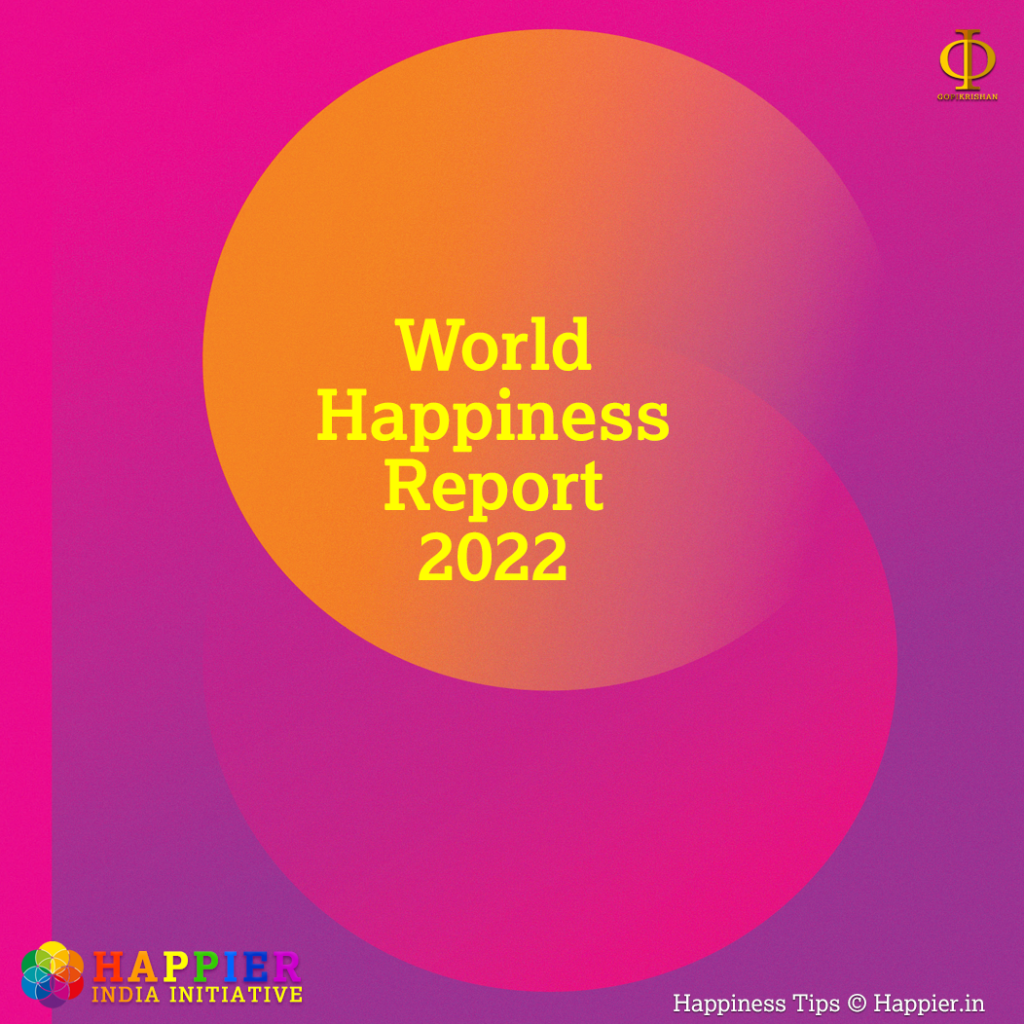The 10th Anniversary Edition of the World Happiness Report was released on 18th March 2022.
INDIA is ranked at 136 position, 11th from the bottom
Don’t you feel that we have to focus on What’s Right for Happier India and Do some collective work??
This year marks the 10th anniversary of the World Happiness Report, which uses global survey data to report how people evaluate their own lives in more than 150 countries worldwide. The World Happiness Report 2022 reveals a bright light in dark times. The pandemic brought not only pain and suffering but also an increase in social support and benevolence. As we battle the ills of disease and war, it is essential to remember the universal desire for happiness and the capacity of individuals to rally to each other’s support in times of great need.
You can download the complete World Happiness Report 2022 here.
FYI, The World Happiness Report is a publication of the Sustainable Development Solutions Network, powered by the Gallup World Poll data.
The Report is supported by The Ernesto Illy Foundation, illycaffè, Davines Group, Unilever’s largest ice cream brand Wall’s, The Blue Chip Foundation, The William, Jeff, and Jennifer Gross Family Foundation, The Happier Way Foundation, and The Regenerative Society Foundation.
The World Happiness Report was written by a group of independent experts acting in their personal capacities. Any views expressed in this report do not necessarily reflect the views of any organization, agency or program of the United Nations.
Trends in Conceptions of Progress and Well-Being
The WHR2022 suggest the following trends Trends in conceptions of progress and well-being
(as detailed in Chapter 3):
• Interest in happiness and subjective well-being has risen sharply, whether measured by the frequency of those words in books in multiple global languages, or by the scale of published research, or by the number of government measurement initiatives.
• By contrast, attention to income and GDP is decreasing, and in books published since 2013, the words GDP (or the like) have appeared less frequently than the word ‘happiness’.
•The World Happiness Report is referred to widely, and it is now mentioned twice as often (in books) as the phrase ‘Beyond GDP’, which itself has also been on a rapidly rising trajectory.
• Academic research on happiness has exploded and now involves authors from all over the world.
• When organisations, academics, or governments try to define progress through creating a new set of indicators, they increasingly include measures of happiness. This reflects the strong public appetite for this conception of progress and the growing availability of data on happiness.
• Thus, the science of happiness has much to offer governments devising better policies. But it can never tell them how to handle inequality or questions of long-run sustainability.
Exploring the biological basis for happiness
Exploring the biological basis for happiness was discussed in Chapter 5 of the WHR2022. It says that:
• Genetic studies involving twin or family designs reveal that about 30-40% of the differences in happiness between people within a country are accounted for by genetic differences between people. The other 60-70% of differences between people result from the effect of environmental influences that are independent of the genes.
• Genome-Wide Association Studies show that the genetic influence comes from the cumulative effects of numerous genetic variants, each with small effects. The next step is to use the outcome of these large-scale studies to create a so-called Polygenic Score; a number that summarizes the estimated effect of the many genetic variants on an individual’s phenotype. It reflects an individual’s estimated genetic predisposition for a given trait and can be used as a predictor for that trait.
• Some people are born with a set of genetic variants that makes it easier to feel happy, while others are less fortunate. But genes and environment are generally correlated: genes can affect people’s choice of environment and how others react to them. At the same time, genes can influence how people are affected by the world around them – there is ‘gene-environment
interaction’.
• The most consistent finding with respect to the brain areas involved in well-being is that a more active default mode network (DMN) is related to lower well-being. (The DMN is a large brain network primarily composed of the medial prefrontal cortex, posterior cingulate cortex/ praecuneus, and angular gyrus). This network is most active when a person is not focused on the outside world, and the brain is at wakeful rest, such as during daydreaming and mind-wandering.
• Many other processes in the human body are important for explaining individual differences in happiness and well-being among individuals. For example, based on the limited number of available studies, higher positive emotion is probably associated with higher levels of serotonin and lower levels of cortisol, whereas chronic activity of the immune system is linked to lower well-being.
• We should use findings from genetically informative research to create happiness enhancing interventions, social policies, activities, and environments that make possible the flourishing of genetic potential and simultaneously offset vulnerability and risk.
Balance and Harmony
The Balance and Harmony is discussed in Chapter 6 of WHR2022. It suggest that:
• Among positive experiences, Eastern culture gives special value to experiences of balance and harmony. These are important, low-arousal positive emotions, but they have been relatively neglected in happiness research, which has stronger roots in Western cultures.
• In 2020 for the first time, the Gallup World Poll asked questions on the experience of
- Your life being in balance
- Feeling at peace with your life
- Experiencing calm for a lot of the day
- Preferring a calm life to an exciting life
- Focus on caring for others or self.
• The experiences of balance, peace, and calm are more prevalent in Western countries, which also
experience the highest levels of satisfaction – and they are less prevalent in poorer countries, including those in East Asia.
• The majority of people in almost every country prefer a calmer life to an exciting one. But that
preference is no higher in Eastern countries than elsewhere. However, it is particularly high in the
poorer countries, especially in Africa, where actual calm is low.
• Both balance and peace contribute strongly to a satisfying life in all regions of the world.
Article Info Source: World Happiness Report 2022 . Know more at https://worldhappiness.report/







More Happy Stories
How to Start Your Gratitude Journal
The Transformative Power of Pen and Paper
आनंद अग्रदूत यानी नीलकंठ का जीवन में वापस आना